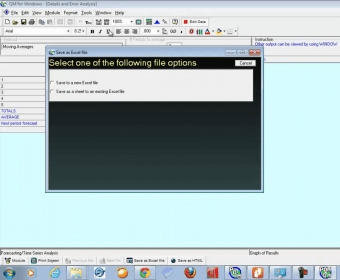
Looking at the end results of the final seasonal indexes, one could see that there is seasonality in the series. It is necessary to measure the seasonality first because it is difficult to measure the trend of a highly seasonal series. The first step in the decomposition method is to find the seasonal indexes by performing a four-period moving average and using a method called the ratio to moving average method (MacGregor, Lichtenstein, Slovic, 1988). C and S are indexes that are proportions centered on: Trend (T), which is measured in the same units as the items being forecasted. Multiplicative Model In the multiplicative decomposition model, which is the most frequently used model, Y is a product of the four components, T, C, S, and e. Methodology: Multiplicative Decomposition Forecasts can provide useful information to cut costs, increase efficient use of resources, and improve the capability to compete in a …show more content… While it is my questionable intention that the seasonal influences for Carlson and the County stores are multiplicative, I will use this method to determine the information needed to justify the losses done by the hurricane. One of the most essential pieces of information useful to compute sales, and the ability to forecast them is strategically important.

#POM QM / TIME SERIES SERIES#
You are assured of an authentic custom paper delivered within the given deadline besides our 24/7 customer support all through.Time Series Analysis: The Multiplicative Decomposition Method You can place an order similar to this with us. Assuming that the average service time for each adviser is the same, how many advisers would the registrar need to hire to bring the waiting time to 10 minutes or less? Yet another way the registrar can reduce the waiting time is to provide additional advisers.Hence, another way the registrar can reduce the waiting time is to provide an assistant to handle routine cases, while the advisor handles the non-routine cases.

The advisor can serve these kinds of routine cases in one minute (with negligible variance). About one-fifth of the students identify their cases as routine.How many assistants should the registrar assign to the adviser if the registrar feels that a waiting time of ten minutes is not unreasonable? Each assistant would reduce the average time required to approve a schedule by 0.2 minutes, down to a minimum of 1.0 minute. One way to reduce the waiting time is to assign some assistants to the adviser.The registrar is considering several ways to reduce the waiting time. Students have complained to the registrar about the length of time they must wait to have their schedules approved. Compute the average time a student spends in the waiting line.

It takes the adviser an average of 2.8 minutes (exponentially distributed) to approve each schedule, and students arrive at the adviser’s office at the rate of 20 per hour (Poisson distributed).Īddress the following using the POM software.
#POM QM / TIME SERIES REGISTRATION#
Scenario: During registration at a university, an adviser must approve students’ course selections.
#POM QM / TIME SERIES SOFTWARE#

Assume a trend analysis (regression over time) forecasting model and build a model for each of the five games (five models in total) by using the forecasting module of the POM software. For this case study, you are required to build a forecasting model. Use the forecasting module that you opened in the POM-QM for Windows software to solve the Southwestern University case study at the end of Chapter 4 of the Heizer and Render (2014) textbook.


 0 kommentar(er)
0 kommentar(er)
